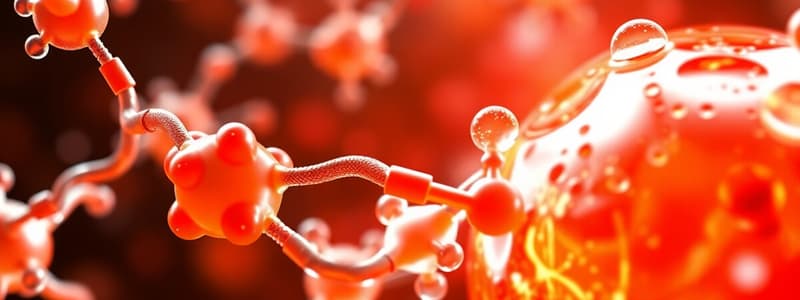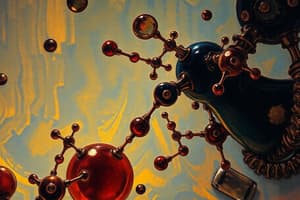Podcast
Questions and Answers
What is the primary role of chlorophyll A in photosynthesis?
What is the primary role of chlorophyll A in photosynthesis?
- To regulate the wavelength of light absorbed
- To energize electrons and transfer them to the primary electron acceptor (correct)
- To absorb water molecules
- To produce oxygen through oxidation
At which wavelengths do Photosystem I (P700) and Photosystem II (P680) primarily absorb light?
At which wavelengths do Photosystem I (P700) and Photosystem II (P680) primarily absorb light?
- P700 at 750 nm and P680 at 670 nm
- P700 at 700 nm and P680 at 680 nm (correct)
- P700 at 680 nm and P680 at 600 nm
- P700 at 600 nm and P680 at 700 nm
What is produced as a byproduct of water oxidation during photosynthesis?
What is produced as a byproduct of water oxidation during photosynthesis?
- ATP
- NADPH
- Oxygen (correct)
- Carbon dioxide
Which process primarily drives the synthesis of NADPH and ATP in photosynthesis?
Which process primarily drives the synthesis of NADPH and ATP in photosynthesis?
What happens to the energized electron after it reaches the primary electron acceptor?
What happens to the energized electron after it reaches the primary electron acceptor?
What is the purpose of RuBP in photosynthesis?
What is the purpose of RuBP in photosynthesis?
What are the main inputs required for the Calvin Cycle to function?
What are the main inputs required for the Calvin Cycle to function?
During photosynthesis, what is produced from the breakdown of water?
During photosynthesis, what is produced from the breakdown of water?
What is a product of the Calvin Cycle?
What is a product of the Calvin Cycle?
What compound is formed when 6 CO2 molecules are fixed in the Calvin Cycle?
What compound is formed when 6 CO2 molecules are fixed in the Calvin Cycle?
What is the primary goal of the Calvin Cycle in photosynthesis?
What is the primary goal of the Calvin Cycle in photosynthesis?
Which organelle is responsible for photosynthesis?
Which organelle is responsible for photosynthesis?
What role do pigments play in photosynthesis?
What role do pigments play in photosynthesis?
Which of the following components is generated during the light reactions of photosynthesis?
Which of the following components is generated during the light reactions of photosynthesis?
What happens to electrons in chlorophyll when light is absorbed?
What happens to electrons in chlorophyll when light is absorbed?
How is ATP produced during the light reaction of photosynthesis?
How is ATP produced during the light reaction of photosynthesis?
What is the significance of the stroma in chloroplasts?
What is the significance of the stroma in chloroplasts?
What is the function of ATP Synthase in photosynthesis?
What is the function of ATP Synthase in photosynthesis?
What role do enzymes play in chemical reactions?
What role do enzymes play in chemical reactions?
Which statement accurately describes the transition state?
Which statement accurately describes the transition state?
Which characteristic of enzymes is true?
Which characteristic of enzymes is true?
How do enzymes affect the activation energy of reactions?
How do enzymes affect the activation energy of reactions?
What type of energy relationship is observed in exothermic reactions?
What type of energy relationship is observed in exothermic reactions?
Which of the following statements is false about enzymes?
Which of the following statements is false about enzymes?
What is the primary composition of most enzymes?
What is the primary composition of most enzymes?
What is the main benefit derived from using enzymes in reactions?
What is the main benefit derived from using enzymes in reactions?
What is the primary function of photosynthesis in plants?
What is the primary function of photosynthesis in plants?
Which of the following organisms are classified as photoautotrophs?
Which of the following organisms are classified as photoautotrophs?
Where in the plant does most photosynthesis occur?
Where in the plant does most photosynthesis occur?
What is the purpose of stomata in plant leaves?
What is the purpose of stomata in plant leaves?
What role do chloroplasts play in plant cells?
What role do chloroplasts play in plant cells?
What is the main chemical equation for photosynthesis?
What is the main chemical equation for photosynthesis?
What is the purpose of veins in plant leaves?
What is the purpose of veins in plant leaves?
What theory explains the multiple membranes found in chloroplasts?
What theory explains the multiple membranes found in chloroplasts?
What is the primary byproduct of photosynthesis?
What is the primary byproduct of photosynthesis?
Which process is direct reverse of photosynthesis?
Which process is direct reverse of photosynthesis?
Flashcards are hidden until you start studying
Study Notes
Enzymes
- Biological catalysts that speed up chemical reactions
- Enzymes assist in metabolic pathways
- Help make reactions start, requiring less energy
- Enzymes are proteins that speed up chemical reactions, making them more likely to happen
- They don't make reactions happen that wouldn't have happened otherwise
- Enzymes make reactions cheaper to run
- Enzymes push reactants up the hill until they reach an energy state high enough for the bonds to break - this is referred to as the transition state
- Transition state is the point at which the reaction goes from needing energy to put into the reaction to releasing energy
- Energy of activation is the energy needed to reach the transition state
- Reactants energy is greater than products energy= Exothermic
- Products energy is greater than reactants energy= Endothermic
- Enzymes speed up a reaction by lowering the energy of activation
- Want to get the benefit with minimal effort
Characteristics of Enzymes
- They don't create reactions
- Not altered or used up by the reaction, they are recycled
- Substrate specific (specific to reaction type)
- Function is based on 3-dimensional shape
- Mostly proteins
Photosynthesis
- Life is powered by solar energy
- Photosynthesis converts solar energy into chemical energy
- Autotrophs are the producers of the biosphere
- Photoautotrophs are photosynthetic organisms including plants, multicellular algae, unicellular protists, cyanobacteria, and purple sulfur bacteria
- Heterotrophs are the consumers of the biosphere and typically depend on photoautotrophs for food and oxygen
Plant Leaf Morphology
- Some plant structures have evolved to absorb sunlight
- Leaves are the main area for photosynthesis
- Leaves have about half a million chloroplasts per square millimeter
- Chloroplasts are found mainly in the mesophyll
- Mesophyll cells are densely packed with chloroplasts (about 30-40 per cell)
- Leaves have a high surface area to act as photosynthetic arrays
- They are wide and thin to absorb sunlight to power photosynthesis
- Leaves are organs composed of tissues (layers of cells) like the mesophyll
- CO2 and O2 enter and exit through stomata and the open/close state is controllable by the plant
- H2O enters through the roots, reaches the leaves through a network of veins and veins export sugar to roots and other non-photosynthetic parts of the plant
- Plants have both chloroplasts for photosynthesis and mitochondria for cellular respiration
- Chloroplasts have multiple membranes because they were once free-living organisms (bacteria) that was engulfed by another organism (eating)
- This deposited another membrane, referred to as the endosymbiotic theory
Chloroplast Structure
- Thylakoid is a cookie-shaped sack in a stacked structure called granum (contains a lumen)
- This is where photosynthesis takes place
- Stroma is the space around the thylakoids
- Chemical equation for photosynthesis is 6CO2 + 12H2O + light -> C6H12O6 + 6O2 + 6H2O
- The reaction is the reverse of cellular respiration
- It's an endergonic redox process
- H2O is oxidized to O2 and CO2 is reduced to glucose
- The goal is to make sugar for food or structure
- Water is oxidized to oxygen, and CO2 is reduced to sugar
Photosynthesis Stages
- Two stages of photosynthesis: the light reaction and the Calvin Cycle (light-independent reaction)
- Light reaction converts light energy into ATP and NADPH (reducing power) which is sent to the Calvin Cycle
- Thylakoid membranes transport the energy from light-dependent reactions to the Calvin Cycle
- Calvin Cycle uses ATP and NADPH to fix carbon
- The goal of the Calvin Cycle is to create glucose from CO2
- This takes place in the stroma
Light Energy
- Light is electromagnetic energy or radiation
- Electromagnetic spectrum ranges from 380 to 750 nm (visible light spectrum)
- Light travels in rhythmic waves but consists of discrete particles called photons
- Photons have a fixed quantity of energy
- Pigments absorb visible light
ATP Production During Photosynthesis
- ATP is made through the same process as cellular respiration
- Hydrogen ion gradient
- Dropping ions through ATP Synthase, spins it to produce ATP
- Stoma/Stomata are openings that allow CO2 and O2 in and out
Light Absorption
- Light energy causes electrons to become excited
- The electrons move to a higher energy shell, which makes them unstable
- They fall back to a stable ground state, releasing heat and a photon (fluorescence)
- Pigments are organized into photosystems in the thylakoid membrane
- Light harvesting complexes are proteins with suspended chlorophyll molecules that can absorb photons of light energy
- This energy is handed off until it gets to paired chlorophyll a molecules, which energizes an electron that jumps up to the primary electron acceptor found in the reaction-center complex
- The primary electron acceptor prevents the energized electron from falling back down
Photosystems
- Two photosystems: Photosystem I (P700) and Photosystem II (P680)
- P700 absorbs wavelengths of 700nm (far-red)
- P680 absorbs wavelengths of 680nm (also red part of the spectrum)
- Light drives the synthesis of NADPH and ATP
- The key to energy transformation is the flow of electrons through photosystems
- There are two types of electron flow: non-cyclic and cyclic electron flow
- Non-cyclic electron flow is the primary type
- Water is oxidized, which provides electrons
- This is why oxygen is produced during photosynthesis
Electron Transport Chain
- Electrons move to an electron transport chain between the photosystems
- This provides energy to regenerate ATP
- ATP is regenerated by sticking electrons onto NADP+
- This requires H+
- H+ is needed for RuBP regeneration (ribulose bisphosphate)
Calvin Cycle
- The input for the Calvin Cycle is 6 CO2
- There are 6 RuBP (ribulose bisphosphate) molecules.
- These bind to the CO2 and result in 12 molecules of 1,3-BPG (bisphosphoglycerate)
- 12 NADPH donate electrons to reduce 12 BPG to 12 G3P (glyceraldehyde 3-phosphate)
- 12 NADP are produced during this reaction
- 12 G3P are converted to 10 G3P and 2 G3P
- These 2 G3P molecules are used to create glucose
- The remaining 10 G3P molecules are recycled back into 6 RuBP molecules
Breaking Down Photosynthesis Stages
- 6 CO2 + 12 H2O + light -> sugar + 6 O2 + 6 H2O
- H2O is the source of electrons
- This is extracted from the stripping off of electrons and H
- CO2 is the source of carbon fixed into organic molecules
- Water is oxidized to oxygen
- Light-dependent reactions produce ATP and NADPH
- The Calvin Cycle produces sugar
- Light-dependent reactions require water and produce oxygen
- The Calvin Cycle requires CO2 and produces sugar
Studying That Suits You
Use AI to generate personalized quizzes and flashcards to suit your learning preferences.



